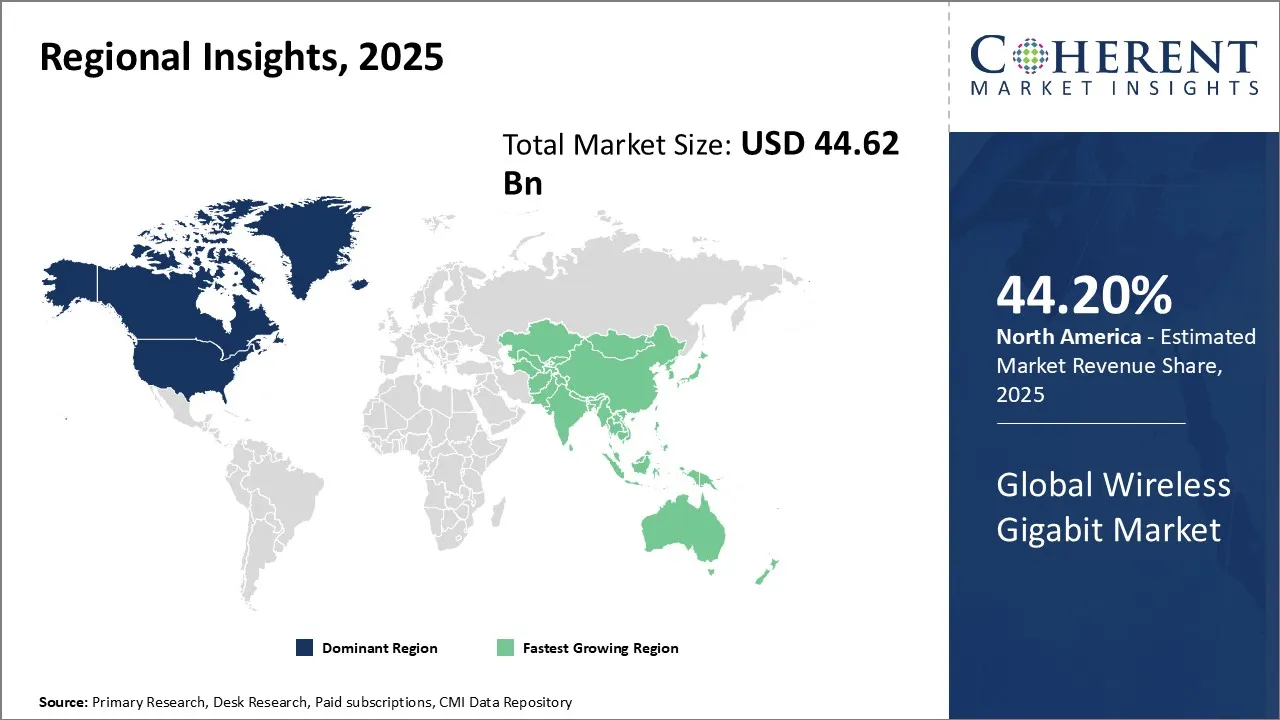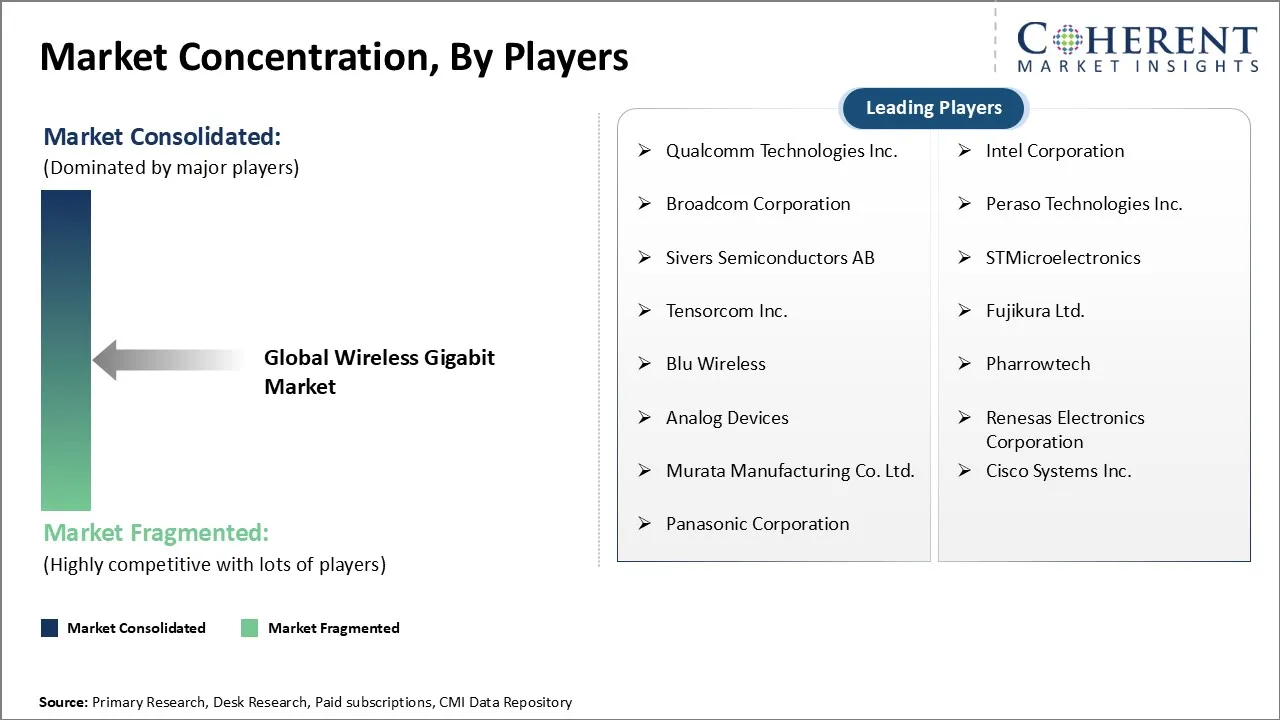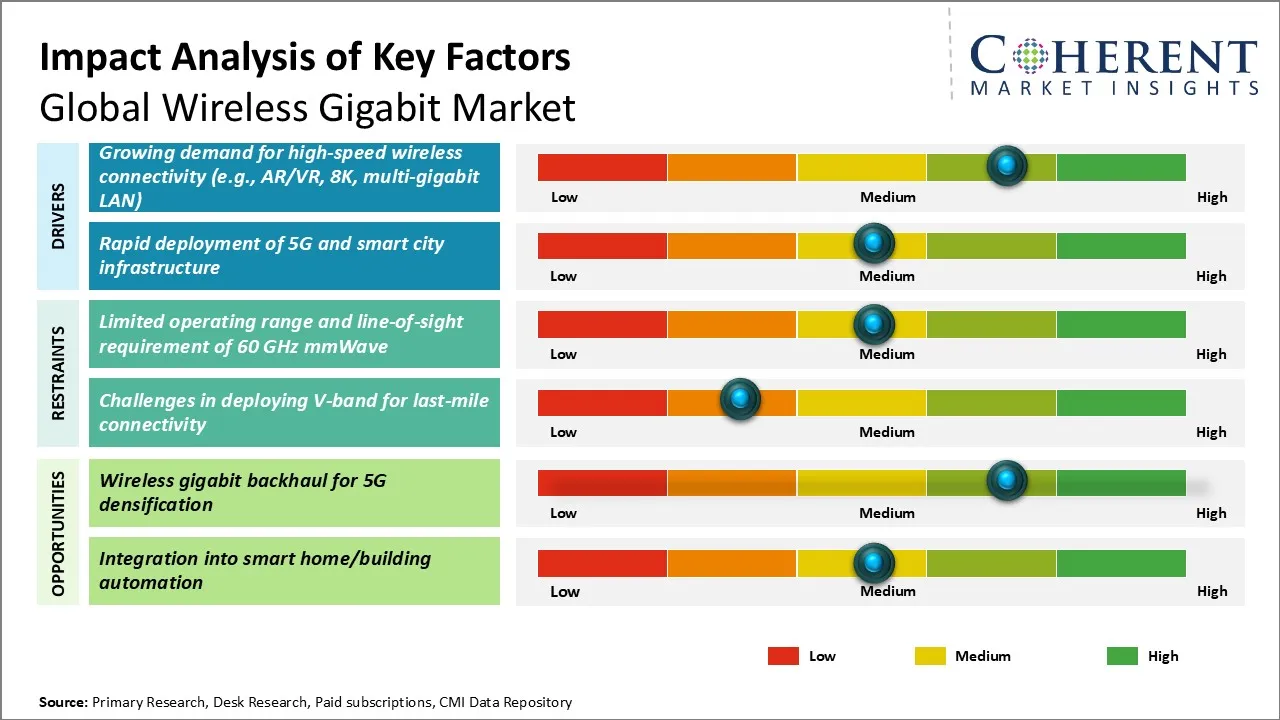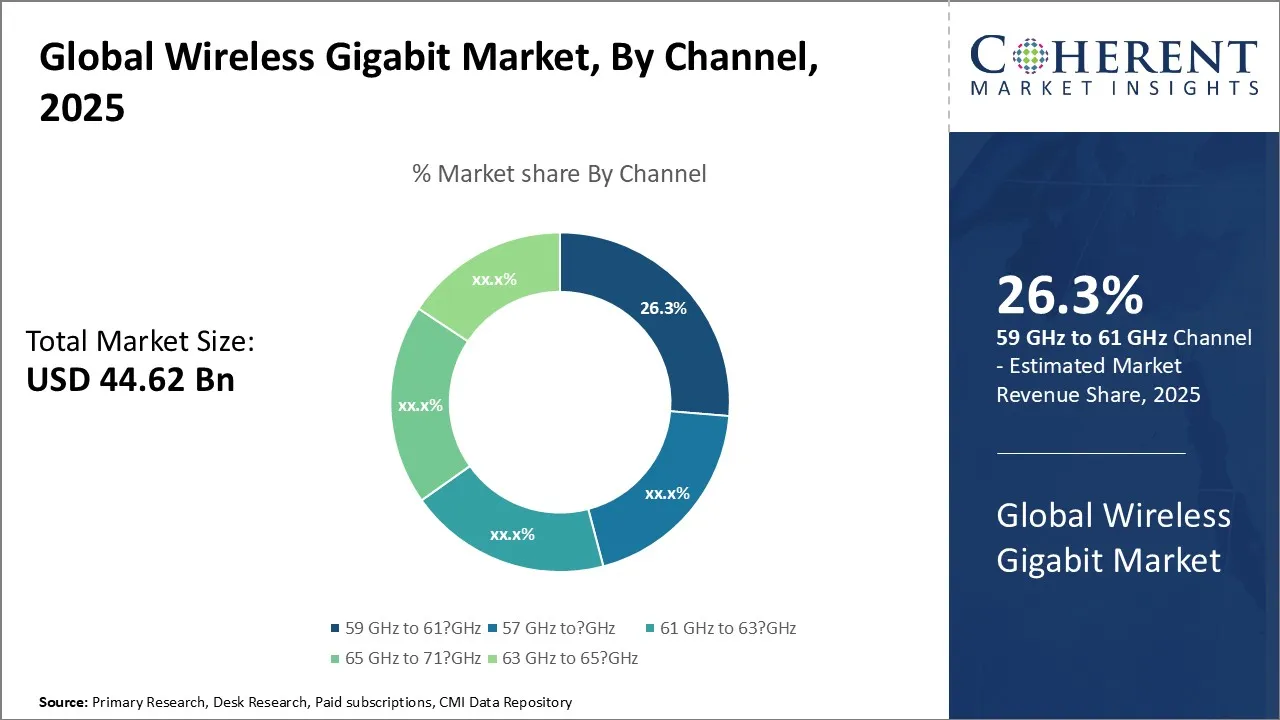Global Wireless Gigabit Market Size and Forecast
The Global Wireless Gigabit Market is estimated to be valued at USD 44.62 B n in 2025 and is expected to reach USD 217.58 Bn by 2032, exhibiting a compound annual growth rate (CAGR) of 25.4% from 2025 to 2032.
Key Takeaways of the Global Wireless Gigabit Market
- The 59 GHz to 61 GHz segment leads the market, holding an estimated share of 26. 3% in 2025.
- The IEEE 802.11ad segment leads the market, holding an estimated share of 56. 8% in 2025.
- North America is estimated to lead the market with a share of 44.2% in 2025. Asia Pacific, holding a share of 29.4% in 2025, is projected to be the fastest growing region.
Market Overview
The trend in the wireless gigabit market is characterized by the development of innovative solutions that enable faster data transmission, lower latency, and improved network reliability. Market Players are focusing on research and development to introduce cutting-edge technologies, such as 60 GHz millimeter-wave communication and advanced beamforming techniques. Additionally, the increasing deployment of 5G networks and the growing demand for wireless gigabit solutions in various industries, including healthcare, education, and entertainment, are adding to market growth.
Current Events and their Impact
|
Current Events |
Description and its impact |
|
Intensifying Global Rollout of 5G Networks |
|
|
Technological Innovations and Enhanced Standardization in Wireless Gigabit Technologies |
|
Uncover macros and micros vetted on 75+ parameters: Get instant access to report
Global Wireless Gigabit Market Insights, by Channel - 59 GHz to 61 GHz Dominates the Market Due to its Superior Performance and Compatibility
The 59 GHz to 61 GHz segment is expected to contribute the highest share of 26.3% in the market in 2025. This frequency range allows for the transmission of large amounts of data over short distances, making it ideal for applications such as wireless docking, high-resolution video streaming, and virtual reality. The high bandwidth available in this segment enables seamless connectivity and eliminates the need for cumbersome wires, enhancing user convenience and mobility.
Moreover, the 59 GHz to 61 GHz band is compatible with the widely adopted IEEE 802.11ad standard, also known as WiGig. The widespread support for the IEEE 802.11ad standard has accelerated the adoption of 59 GHz to 61 GHz solutions across various industries, including consumer electronics, automotive, and healthcare.
Another factor contributing to the dominance of the 59 GHz to 61 GHz segment is its ability to mitigate interference from other wireless technologies. This frequency band is less congested compared to lower frequency ranges, such as the 2.4 GHz and 5 GHz bands used by traditional Wi-Fi.
Global Wireless Gigabit Market Insights, by Protocol – IEEE 802.11ad Leads the Market with its Established Ecosystem and Widespread Adoption
In terms of protocol, the IEEE 802.11ad segment is projected to contribute the highest share of 56.8% in the market in 2025, due to its established ecosystem, widespread adoption, and strong industry support. IEEE 802.11ad is a well-established wireless standard that has gained significant traction in the wireless gigabit market.
One of the key factors driving the growth of the IEEE 802.11ad segment is its mature ecosystem. The standard has been in development for several years, and numerous companies have invested in creating compatible devices and solutions. This has resulted in a wide range of IEEE 802.11ad-compliant products, including laptops, smartphones, routers, and docking stations. The availability of a diverse range of products has accelerated the adoption of IEEE 802.11ad in both consumer and enterprise markets.
Another factor contributing to the dominance of IEEE 802.11ad is its ability to deliver high-speed, low-latency wireless connectivity. The standard operates in the 60 GHz frequency band, which allows for the transmission of large amounts of data over short distances. This makes IEEE 802.11ad well-suited for applications that require high bandwidth such as wireless docking, high-quality video streaming, and gaming. The superior performance offered by IEEE 802.11ad has made it an attractive choice for consumers and businesses alike.
Impact of Artificial Intelligence (AI) in the Market
Artificial Intelligence (AI) is playing an critical role in the global wireless gigabit market, primarily by enhancing network performance, managing complex multi-gigabit connections, and optimizing spectrum utilization at millimeter-wave frequencies like 60 GHz. AI-driven algorithms are used for dynamic beamforming, interference mitigation, and predictive network management, enabling wireless gigabit systems to deliver stable, high-speed connections even in environments with dense device populations or obstacles. In addition, AI facilitates adaptive modulation and coding schemes that adjust in real time to environmental conditions, ensuring consistent throughput and low latency for applications like AR/VR, ultra-HD streaming, and wireless docking.
Qualcomm uses AI in its FastConnect systems, where AI techniques improve 60 GHz beam selection and tracking to maintain strong wireless links, even when users move around or when devices encounter obstructions. This was highlighted in its FastConnect 6900 platform, which combines AI-powered decision-making with WiGig (802.11ay) to deliver faster and more reliable wireless docking and VR headset connectivity.
Regional Insights

To learn more about this report, Download Free Sample
North America Wireless Gigabit Market Analysis and Trends
North America, holding a share of 44.20% in 2025, is expected to dominate the global wireless gigabit market. The region boasts a robust market ecosystem, with a strong presence of key industry players and advanced technological infrastructure. Notable companies, such as Qualcomm, Intel, and Broadcom, have made significant contributions to the development and commercialization of wireless gigabit solutions in North America. In March 2024, Qualcomm announced its FastConnect 7900 platform, integrating Wi‑Fi 7 and enhanced 60 GHz WiGig support with AI-driven beam management for improved reliability in AR/VR and wireless docking applications.
Asia Pacific Wireless Gigabit Market Analysis and Trends
Asia Pacific region, holding a share of 29.4% in 2025, is projected to witness the fastest growth in the global wireless gigabit market. The rapid urbanization, increasing disposable incomes, and the proliferation of smart devices have created a massive demand for high-speed wireless connectivity in the region. Countries like China, Japan, and South Korea have been early adopters of wireless gigabit technology, leveraging it to enable advanced applications in industries such as automotive, gaming, and virtual reality.
Companies like Samsung, Huawei, and Sony have been instrumental in driving innovation and wireless gigabit market expansion in the Asia Pacific region. In January 2024, Samsung unveiled its new 60 GHz wireless gigabit module for automotive in-cabin connectivity.
Global Wireless Gigabit Market Outlook for Key Countries
U.S. Wireless Gigabit Market Analysis and Trends
The U.S. has a tech-savvy consumer base and the presence of leading technology companies. The increasing demand for high-quality video streaming, gaming, and virtual reality experiences is boosting the adoption of wireless gigabit solutions in the U.S. Key players, such as Qualcomm, Intel, and Broadcom, have been actively involved in the development and deployment of wireless gigabit products and services in the country.
China Wireless Gigabit Market Analysis and Trends
China wireless gigabit market has experienced significant growth, driven by the country's large population, rapid urbanization, and increasing disposable incomes. The Chinese government's initiatives to promote the development of advanced wireless networks, such as 5G, have further accelerated the adoption of wireless gigabit solutions. The country's thriving electronics manufacturing industry and the presence of major players like Huawei and ZTE have also contributed to the growth of the wireless gigabit market in China. The increasing demand for high-speed wireless connectivity in industries, such as automotive, healthcare, and education, has opened up new opportunities for wireless gigabit market expansion.
Japan Wireless Gigabit Market Analysis and Trends
Japan continues to lead in the adoption and development of wireless gigabit technology, leveraging its expertise in advanced electronics and telecommunications. The country's tech-savvy population and the increasing demand for high-quality multimedia experiences have driven the growth of the wireless gigabit market in Japan. The government's support for the development of advanced wireless networks and the presence of major players like Sony and Panasonic have further contributed to the market's growth. The Japanese market has also seen significant adoption of wireless gigabit solutions in industries such as gaming, entertainment, and automotive.
Germany Wireless Gigabit Market Analysis and Trends
Germany's market for wireless gigabit technology has been driven by the country's strong focus on innovation and its advanced telecommunications infrastructure. The increasing demand for high-speed wireless connectivity in industries, such as automotive, manufacturing, and healthcare, has fueled the adoption of wireless gigabit solutions in Germany. The country's leading automotive companies, such as BMW and Daimler, have been actively exploring the integration of wireless gigabit technology in their vehicles to enable advanced features like autonomous driving and in-car entertainment. The German government's initiatives are promoting the development of Industry 4.0. The increasing adoption of smart factory solutions are further accelerating the growth of the wireless gigabit market in the country.
Market Players, Key Development, and Competitive Intelligence

To learn more about this report, Download Free Sample
Key Developments
- In May 2025, Peraso Inc. participated in Wireless Expo Japan 2025 at Tokyo Big Sight. The company showcased its latest 60GHz mmWave solutions for fixed wireless access (FWA), tactical communications, wireless video, and VR applications.
- In July 2024, Qualcomm Technologies, Inc. announced the Snapdragon 4s Gen 2 Mobile Platform, designed to make 5G more accessible and reliable.
- In January 2024, Cavli Wireless unveiled its latest innovation, the CQM220 5G RedCap Cellular IoT Module at CES 2024.
- In June 2021, Cambium Networks, a global provider of wireless networking solutions, shipped the 10 millionth radio since its inception in October of 2011.
Top Strategies Followed by Global Wireless Gigabit Market Players
- Established players are investing heavily in R&D to stay ahead of the competition and offer cutting-edge solutions to their customers.
- Qualcomm has continuously invested in mmWave R&D, evident in its development of FastConnect 7800 with advanced 60 GHz WiGig support.
- Mid-level players are focusing on delivering cost-effective solutions to target price-sensitive consumers.
- Peraso Inc. offers cost-effective 60 GHz modules like its PRM2141 series, which delivers reliable multi-gigabit connectivity at competitive pricing.
- Small-scale players often specialize in niche markets, offering unique features or innovative products to differentiate themselves from larger competitors.
- Blu Wireless has carved out a niche by specializing in 60 GHz solutions for high-speed rail connectivity and smart city.
Market Report Scope
Wireless Gigabit Market Report Coverage
| Report Coverage | Details | ||
|---|---|---|---|
| Base Year: | 2024 | Market Size in 2025: | USD 44.62 Bn |
| Historical Data for: | 2020 To 2024 | Forecast Period: | 2025 To 2032 |
| Forecast Period 2025 to 2032 CAGR: | 25.4% | 2032 Value Projection: | USD 217.58 Bn |
| Geographies covered: |
|
||
| Segments covered: |
|
||
| Companies covered: |
Qualcomm Technologies Inc., Intel Corporation, Broadcom Corporation, Peraso Technologies Inc., Sivers Semiconductors AB, STMicroelectronics, Tensorcom Inc., Fujikura Ltd., Blu Wireless, Pharrowtech, Analog Devices, Renesas Electronics Corporation, Murata Manufacturing Co. Ltd., Cisco Systems Inc., and Panasonic Corporation |
||
| Growth Drivers: |
|
||
| Restraints & Challenges: |
|
||
Uncover macros and micros vetted on 75+ parameters: Get instant access to report
Market Dynamics

To learn more about this report, Download Free Sample
Global Wireless Gigabit Market Driver - Growing Demand for High-speed Wireless Connectivity (e.g., AR/VR, 8K, multi ‑ gigabit LAN)
As technologies such as augmented reality (AR), virtual reality (VR), 8K video streaming, and multi-gigabit local area networks (LANs) gain traction, the need for robust and reliable wireless networks capable of handling vast amounts of data becomes paramount. Consumers and businesses alike are seeking seamless, high-quality experiences that require low latency and high bandwidth, which wireless gigabit technology can provide.
In 2024, Meta (formerly Facebook) partnered with Qualcomm to enhance wireless performance for its Meta Quest Pro and Quest 3 VR headsets, which support multi-gigabit wireless streaming via WiGig (60 GHz) for untethered, high-resolution VR experiences. The rising adoption of these data-intensive applications across industries such as gaming, entertainment, healthcare, education, and enterprise collaboration is propelling the demand for wireless gigabit solutions.
Global Wireless Gigabit Market Opportunity - Wireless Gigabit Backhaul for 5G Densification
As 5G networks continue to expand and densify, there is a growing need for efficient and reliable backhaul solutions to connect the numerous small cells and base stations. Wireless gigabit technology, particularly in the 60 GHz mmWave band, offers a promising solution for 5G backhaul. With its ability to deliver multi-gigabit data rates and low latency, wireless gigabit technology can provide the necessary capacity and performance to support the demanding requirements of 5G networks. Facebook’s Terragraph initiative, in collaboration with companies like Cambium Networks and Blu Wireless, uses 60 GHz wireless gigabit links to provide affordable, high-capacity backhaul for 5G small cells and dense urban networks.
By leveraging wireless gigabit links, operators can quickly and cost-effectively deploy backhaul infrastructure in dense urban areas and other locations where fiber deployment may be challenging or cost-prohibitive. The flexibility and scalability of wireless gigabit backhaul solutions enable operators to dynamically adapt to changing network demands and support the rapid densification of 5G networks.
Analyst Opinion (Expert Opinion)
- Next-generation devices are increasingly integrating 60 GHz WiGig with Wi‑Fi 7 and mmWave 5G, enabling seamless handoff between ultra-high-speed local links and wide-area networks. This synergy supports demanding applications like untethered AR/VR, wireless docking, and edge computing with unprecedented speed and reliability.
- Emerging 60 GHz mesh solutions are providing gigabit-grade alternatives to fiber for smart city infrastructure, transit systems, and industrial automation. Platforms like Terragraph demonstrate how wireless gigabit can bridge the digital divide and support 5G small cell backhaul in urban and rural environments alike.
- Vendors are embedding AI to optimize beam steering, interference avoidance, and link adaptation in real time. These capabilities are critical for maintaining stable, high-throughput connections in complex, high-density settings—from esports arenas to future metaverse hubs.
Market Segmentation
- Channel Insights (Revenue, USD Bn, 2020 - 2032)
- 59 GHz to 61 GHz
- 57 GHz to GHz
- 61 GHz to 63 GHz
- 65 GHz to 71 GHz
- 63 GHz to 65 GHz
- Protocol Insights (Revenue, USD Bn, 2020 - 2032)
- IEEE 80211ad
- IEEE 80211ay
- Regional Insights (Revenue, USD Bn, 2020 - 2032)
- North America
- U.S.
- Canada
- Latin America
- Brazil
- Argentina
- Mexico
- Rest of Latin America
- Europe
- Germany
- U.K.
- Spain
- France
- Italy
- Russia
- Rest of Europe
- Asia Pacific
- China
- India
- Japan
- Australia
- South Korea
- ASEAN
- Rest of Asia Pacific
- Middle East
- GCC Countries
- Israel
- Rest of Middle East
- Africa
- South Africa
- North Africa
- Central Africa
- North America
- Key Players Insights
- Qualcomm Technologies Inc.
- Intel Corporation
- Broadcom Corporation
- Peraso Technologies Inc.
- Sivers Semiconductors AB
- STMicroelectronics
- Tensorcom Inc.
- Fujikura Ltd.
- Blu Wireless
- Pharrowtech
- Analog Devices
- Renesas Electronics Corporation
- Murata Manufacturing Co. Ltd.
- Cisco Systems Inc.
- Panasonic Corporation
Sources
Primary Research Interviews
Stakeholders
- Wireless chipset manufacturers (e.g., Qualcomm, Peraso, Sivers Semiconductors)
- Consumer electronics OEMs (e.g., Lenovo, Asus, HP)
- Telecom operators and fixed wireless access providers (e.g., Verizon, Rakuten Mobile)
- AR/VR device manufacturers (e.g., Meta, HTC Vive)
- Network infrastructure providers (e.g., Cambium Networks, Blu Wireless)
- Regulatory authorities and spectrum management agencies
Databases
- Global Telecom Equipment Database (GTED)
- U.S. Federal Communications Commission (FCC) Spectrum Reports
- Japan Spectrum Management Database (JSMD)
- European Telecommunications Standards Institute (ETSI) Reports
Magazines
- Wireless Tech Review
- Next-Gen Connectivity Monthly
- Gigabit Wireless Insights
- Millimeter Wave Technology Magazine
Journals
- Journal of Wireless Networking & Technologies
- IEEE Journal on Millimeter-Wave Communications
- International Journal of Next-Generation Networks
- Telecom Systems and Engineering Review
Newspapers
- Telecom Daily News
- Global Connectivity Times
- The Wireless Observer
- Digital Infrastructure Chronicle
Associations
- Millimeter Wave Communications Alliance (MWCA)
- Global Wireless Gigabit Consortium (GWGC)
- International Telecommunications Union (ITU)
- Wi-Fi Alliance
- Wireless Broadband Alliance (WBA)
Public Domain Sources
- U.S. Census Bureau
- EUROSTAT
- United Nations Economic Commission for Europe (UNECE)
- World Bank
- ResearchGate
Proprietary Elements
- CMI Data Analytics Tool, Proprietary CMI Existing Repository of Information for Last 8 Years
Share
Share
About Author
Monica Shevgan has 9+ years of experience in market research and business consulting driving client-centric product delivery of the Information and Communication Technology (ICT) team, enhancing client experiences, and shaping business strategy for optimal outcomes. Passionate about client success.
Missing comfort of reading report in your local language? Find your preferred language :
Transform your Strategy with Exclusive Trending Reports :
Frequently Asked Questions
EXISTING CLIENTELE
Joining thousands of companies around the world committed to making the Excellent Business Solutions.
View All Our Clients


